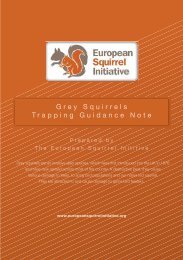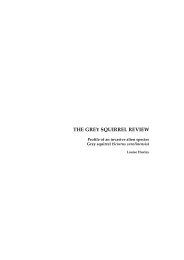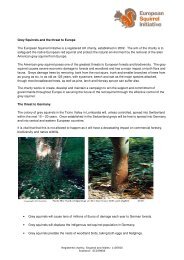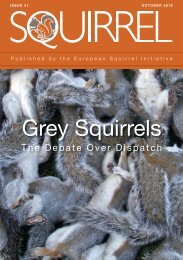6. quantification and financial implications of grey squirrel damage
6. quantification and financial implications of grey squirrel damage
6. quantification and financial implications of grey squirrel damage
Create successful ePaper yourself
Turn your PDF publications into a flip-book with our unique Google optimized e-Paper software.
<strong>squirrel</strong>s. Current research by Broome (including the new national survey) will allow a more<br />
precise evaluation (Broome & Johnson 2000).<br />
The Forestry Commission quotes similar figures today, 20 years on from the original survey.<br />
It cites the economic cost <strong>of</strong> <strong>grey</strong> <strong>squirrel</strong> <strong>damage</strong> to timber in Great Britain (again discounted<br />
at 6% to a common year <strong>of</strong> 2000) as an estimated reduction in value <strong>of</strong> current tree crops by<br />
around 25% (or £10 million) (FC Engl<strong>and</strong> Grey Squirrel Policy, in press). No specific<br />
estimates <strong>of</strong> the cost <strong>of</strong> <strong>damage</strong> to commercial tree crops in either the public or the private<br />
forestry sectors have been published, but together they are likely to exceed a million pounds<br />
per year (Gurnell & Mayle 2002). The costs <strong>of</strong> <strong>damage</strong> to the 199,000 ha <strong>of</strong> state owned forests<br />
in Engl<strong>and</strong> have been estimated at £2 million over the period <strong>of</strong> a crop rotation for <strong>damage</strong> to<br />
sycamore, beech <strong>and</strong> oak alone. An additional £224,000 per year represents the cost <strong>of</strong><br />
<strong>damage</strong> to conifers (Mayle 2002). Red <strong>squirrel</strong>s have also been known to cause <strong>damage</strong> to<br />
woodl<strong>and</strong>s, but the consequences have never been as economically pr<strong>of</strong>ound mainly because<br />
their density is lower.<br />
Value <strong>of</strong> crops at risk<br />
Given that a significant proportion <strong>of</strong> the plantations at risk to <strong>damage</strong> are stocked with<br />
broadleaved species, for which the rotations are very long, the estimation <strong>of</strong> current value by<br />
discounting future income is not ideal. The economics <strong>of</strong> broadleaved plantations, in terms <strong>of</strong><br />
timber production, are debatable <strong>and</strong> most investors are more likely to view such investment<br />
as a means to h<strong>and</strong>-on assets to future generations. It may therefore be more realistic to<br />
consider the true value <strong>of</strong> the sunk investment that is at risk. Without that investment the<br />
wider benefits <strong>of</strong> forestry would not be available to society (Inglis pers comm. 2003).<br />
Table <strong>6.</strong>4, Areas <strong>of</strong> plantations <strong>of</strong> the most vulnerable species planted between 1961 <strong>and</strong><br />
1990 (Ha) (Source: National inventory <strong>of</strong> woodl<strong>and</strong>s <strong>and</strong> trees. Forestry Commission 2003)<br />
Species 1981-1990 1971-1980 1961-1970<br />
Scots pine 12,471 18,571 44,685<br />
Corsican pine 6,271 7,444 9,547<br />
Norway spruce 3,995 9,202 21,822<br />
Larch 14,992 15,926 23,395<br />
Oak 3,761 2,518 3,590<br />
Beech 1,128 2,066 6,114<br />
Sycamore 1,806 4,019 5,024<br />
Sweet chestnut 578 431 677<br />
Total 44,930 67,,450 114,904<br />
81







